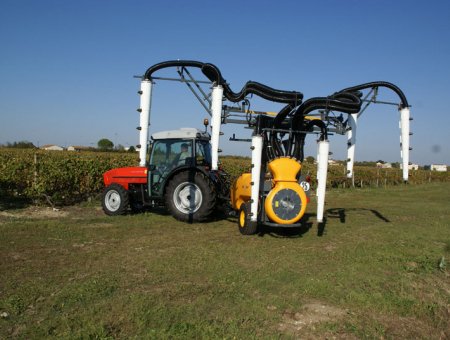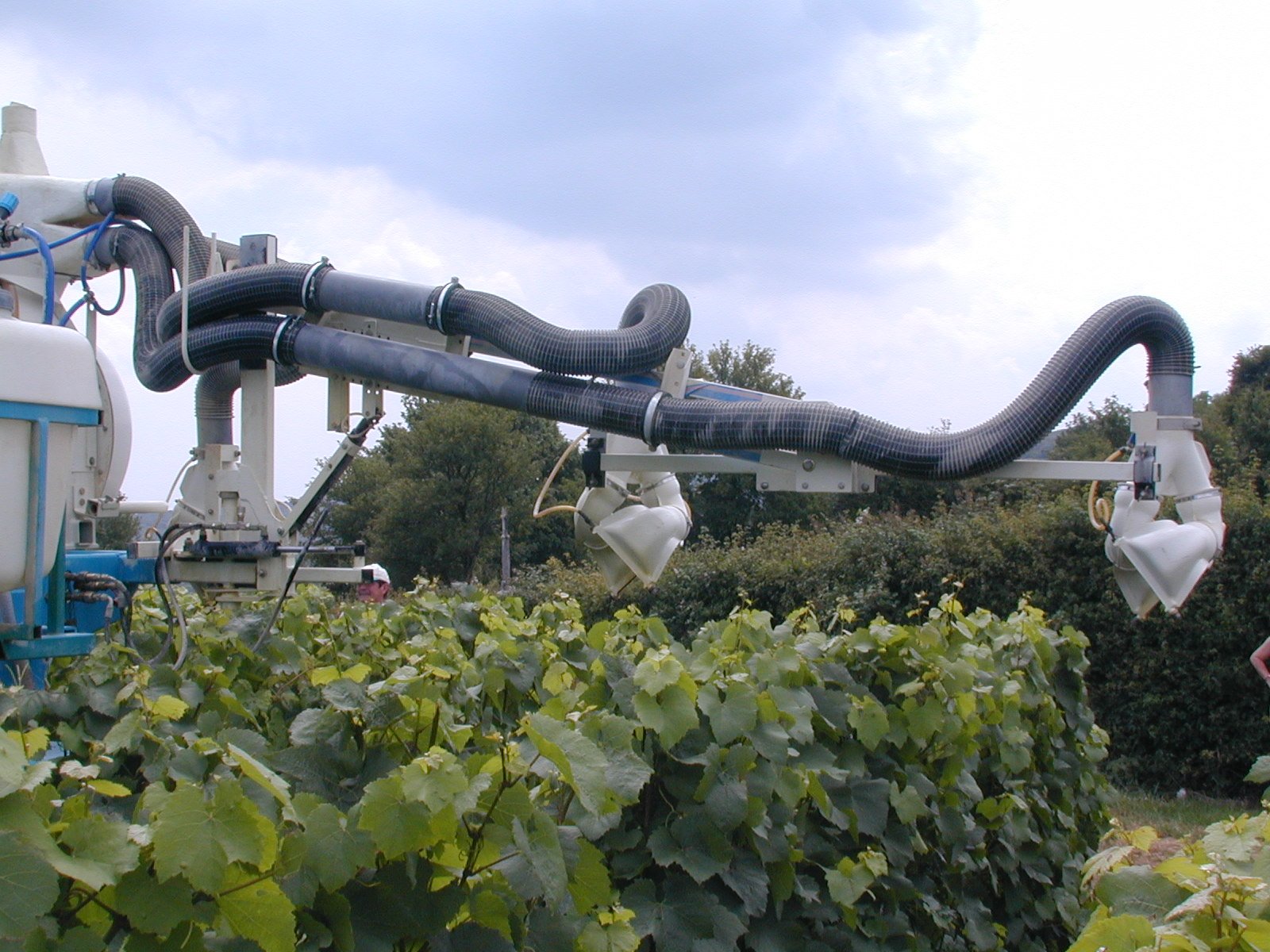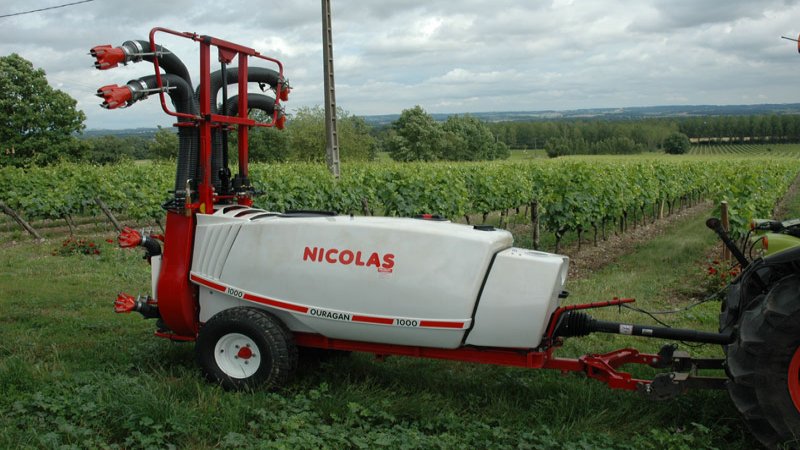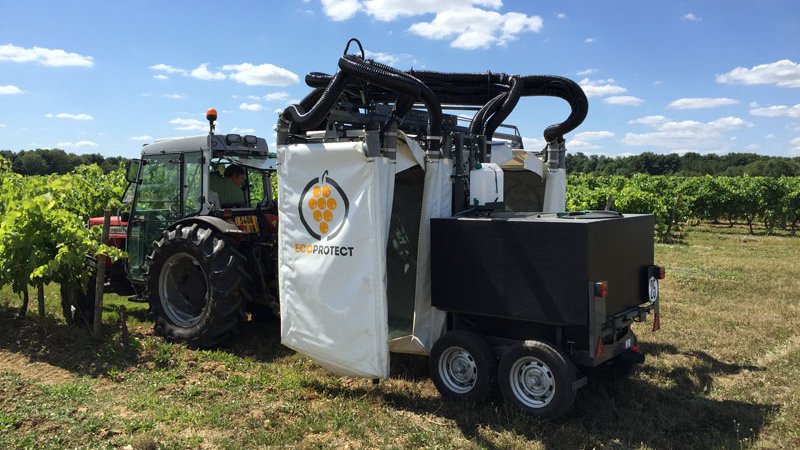Pneumatic sprayer
A pneumatic sprayer uses high-speed air to break up and transport the spray liquid to the vegetation. The spray liquid is fed into a venturi cone where it comes into contact with an air flow at around 300 km/h, breaking up the liquid into fine droplets of 50 to 150 microns. The pressure in the liquid circuit is 2 to 3 bars to ensure a regular flow. Efficiency depends on the PTO speed of 540 rpm, which guarantees a high air flow and adequate spray fineness. Too fine a spray can lead to drift and desiccation losses.

Technical presentation
The operating principle of the pneumatic sprayer has nothing in common with the other two systems. Here, air is used not only to transport the droplet to the target, but also to break up the liquid stream. The operation of a pneumatic sprayer can be compared to that of a carburettor.
On the first devices, the very low pressure in the liquid circuit was only used to dose the quantity of spray mixture to be introduced into a venturi cone or similar system. Nowadays, a pressurised spray mixture combined with a pellet or nozzle system (used to calibrate the flow rate only) is the standard method. At the venturi, contact between the liquid and a stream of air at a speed of around 300 km/hour (when everything is going well) causes the liquid to break up into very fine droplets (50 to 150 microns). The finer the drops, the smaller the quantity of liquid introduced into the air and the higher the speed of the air stream.
On the first devices, the very low pressure in the liquid circuit was only used to dose the quantity of spray mixture to be introduced into a venturi cone or similar system. Nowadays, a pressurised spray mixture combined with a pellet or nozzle system (used to calibrate the flow rate only) is the standard method. At the venturi, contact between the liquid and a stream of air at a speed of around 300 km/hour (when everything is going well) causes the liquid to break up into very fine droplets (50 to 150 microns). The finer the drops, the smaller the quantity of liquid introduced into the air and the higher the speed of the air stream.

Pneumatic face-to-face sprayer
Pressure and power take-off

Pneumatic sprayer boom
Pressures were very low at the start of this technique, but have gradually increased to between 2 and 3 bar. The aim of this increase in pressure is to ensure a more even flow at the various points in the circuit by limiting the impact of pressure drops. 1 bar corresponds roughly to a height of 10 m in the water column and to 1 kg/cm².
For pneumatic spraying, it is essential to work at a PTO speed of 540 rpm to benefit from a high air flow (and therefore a high speed at the air/liquid interface) and thus obtain a good spray fineness.
Excessive droplet fineness should not be sought, however, as there are considerable losses through drift, but also through desiccation. The higher the air temperature, the lower the humidity and the greater the distance between the sprayer and the target, the greater the desiccation
For pneumatic spraying, it is essential to work at a PTO speed of 540 rpm to benefit from a high air flow (and therefore a high speed at the air/liquid interface) and thus obtain a good spray fineness.
Excessive droplet fineness should not be sought, however, as there are considerable losses through drift, but also through desiccation. The higher the air temperature, the lower the humidity and the greater the distance between the sprayer and the target, the greater the desiccation
Different types of pneumatic sprayer

Pneumatic face-to-face sprayer

Vaulted pneumatic sprayer

Pneumatic sprayer with recovery panels
Experiment
See the list of experimentsSee more - Setting up your pneumatic sprayer - 2020
- [EQUIPMENT TEST] Adjustment sheet: Amos TB+ pneumatic sprayer - 2020
- [EQUIPMENT TEST] Adjustment sheet: Berthoud CG Expert Airmist duo pneumatic sprayer - 2020
- [EQUIPMENT TEST] Adjustment sheet: Bobard JET 5000/6000 pneumatic sprayer - 2020
- [EQUIPMENT TEST] Adjustment sheet: Bobard JET 7000 pneumatic sprayer - 2020
- [EQUIPMENT TEST] Adjustment sheet: aeroconvector turbine / chenillard - 2017
- [EQUIPMENT TEST] Adjustment sheet: Berthoud CG Expert pneumatic sprayer - 2015
- [EQUIPMENT TEST] Adjustment sheet: Bobard JET 6000 pneumatic sprayer - 2015
